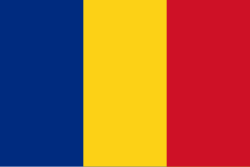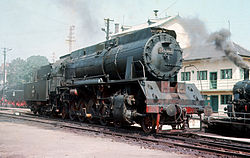Kingdom of Romania
The Kingdom of Romania (or 'Romania' after 1969) was a constitutional monarchy which existed between 13 March 1881 and 30 December 1947, specified by the First (in 1866), and respectively, the Second Constitution of Romania. Thus, the Kingdom of Romania began with the reign of King Carol I of Romania and later replaced by Michael I of Romania . It's Prime minister was Ion Antonescu who was prime minister from 1940-1944 . He was later executed in 1946, 2 years after the defeat of Nazi Germany, Italy, Hungary, Croatia, Romania, Bulgaria and Japan, which were the countries in the Axis Powers who were defeated in 1945.
Kingdom of Romania (1881–1947) Regatul României National Legionary State (1940–1941) Statul Național Legionar | |
|---|---|
| 1881–1947 | |
| 'Motto: | |
| Anthem: | |
| ' | |
 Romania in 1942 | |
| Capital | Bucharest (1881–1916, 1918–1947) Iași (Jassy) (1916–1918) |
| Common languages | Romanian (official)[1] German, and Hungarian |
| Religion | Romanian Orthodox |
| Government | Constitutional monarchy (1881–1937; 1944–1947) Absolute monarchy (1938–1940) Fascist dictatorship (1937–1938; 1940–1941) Military dictatorship (1941–1944) |
| King | |
• 1881–1914 | Carol I |
• 1914–1927 | Ferdinand I |
• 1927–1930 | Michael I (1st reign) |
• 1930–1940 | Carol II |
• 1940–1947 | Michael I (2nd reign) |
| Prime Minister | |
• 1881 | Ion Brătianu (first) |
• 1940–1944 | Ion Antonescu[a] |
• 1945–1947 | Petru Groza (last) |
| Legislature | Parliament |
| Senate | |
| Chamber of Deputies | |
| Historical era | Belle Époque • World War I • Interwar period • World War II |
• | 14 March 1881 |
| 10 August 1913 | |
| 4 June 1920 | |
| 29 March 1923 | |
| 20 February 1938 | |
| 14 September 1940 | |
| 21 January 1941 | |
| 23 August 1944 | |
| 12 September 1944 | |
• | 30 December 1947 |
| Area | |
| 1915[b] | 138,000 km2 (53,000 sq mi) |
| 1940[b][c] | 295,049 km2 (113,919 sq mi) |
| Population | |
• 1915[b] | 7,900,000 |
| 20,058,378 | |
| Currency | Romanian Leu |
a. ^ Was formally declared Conducător (literally, "Leader") of the state on 6 September 1940, by a royal decree which consecrated a ceremonial role for the monarch.[2] b. ^ Area and population according to Ioan Suciu, Istoria contemporana a României (1918–2005).[3] c. ^ The indicator for the localities of Romania (1941).[4] | |
From 1859 to 1877, Romania evolved from a personal union of two vassal principalities (Moldavia and Wallachia) to a full-fledged independent kingdom. During 1918-20, at the end of World War I, Transylvania, Eastern Moldavia (Bessarabia), and Bukovina were united with the Kingdom of Romania. In 1940, Bessarabia, Northern Bukovina, Northern Transylvania and Southern Dobruja were ceded to the Soviet Union, Hungary and Bulgaria. In 1947 the last king was compelled to abdicate from throne. The socialist republic, ruled by the Romanian Communist Party replaced the monarchy after Joseph Stalin occupied Romania in 1945.
Kingdom Of Romania Media
A recording of Trăiască Regele by the Victor Military Band from 1914.
Minelayer Template:NMS
Related pages
References
- ↑ "Constitutiunea din 1923" (in Romanian). Legislatie pentru Democratie. Archived from the original on 26 December 2018. Retrieved 19 September 2011.
{{cite web}}: CS1 maint: unrecognized language (link) - ↑ Dennis Deletant, Hitler's Forgotten Ally: Ion Antonescu and His Regime, Romania, 1940–1944, Palgrave Macmillan, London, 2006. ISBN 1-4039-9341-6
- ↑ Ioan Scurtu (2005). "Istoria contemporana a României (1918-2005)" (in Romanian). Bucharest. Retrieved 19 September 2011.
{{cite web}}: CS1 maint: unrecognized language (link) - ↑ Institutul Central de Statistică (1943). "Indicatorul localităților din România" (PDF) (in Romanian). Archived from the original (PDF) on 4 March 2016. Retrieved 20 October 2015.
{{cite web}}: CS1 maint: unrecognized language (link)









